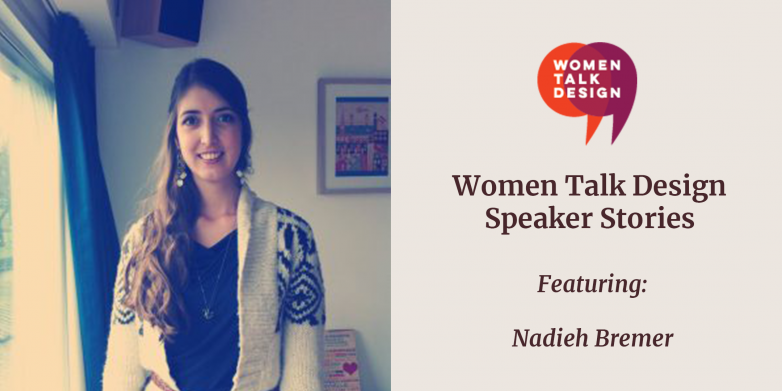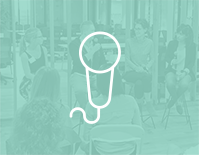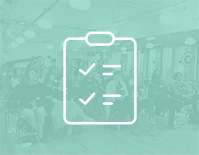Nadieh Bremer on how she’s overcome anxiety and grown as a speaker
As part of our #WTDSpeakerStories, we spoke with Nadieh Bremer about her passion for data visualization and how that led her to speaking. Here is what she had to say about her very first time speaking, how she continues to deal with anxiety in front crowds, and the way her process for finding engagements and building talks has evolved.
In our Women Talk Design Speaker Stories series, we’re interviewing a Women Talk Design speaker every week about their journeys and experiences. We talk to speakers who are just getting started, speakers who have had their fair share of speaking mishaps, speakers writing books, and speakers curating events. At the end, we offer an opportunity for folks from the WTD community to ask their own questions and connect with each other. Visit our events page for more information about the series and RSVP for our next event.

Nadieh Bremer is a graduated Astronomer turned Data Scientist turned Data Visualization Designer. After working for a consultancy & fintech company where she discovered her passion for the visualization of data, she’s now working as a freelancing data visualization designer under the name “Visual Cinnamon”. As 2017’s “Best Individual” in the Information is Beautiful Awards, she focuses on uniquely crafted (interactive) data visualizations that both engage and enlighten audiences. Nadieh believes as long as there’s data, there’s a story to reveal.
On her motivation to become a speaker and her very first talk
Nadieh talked about how she came to speaking because she was so excited about data visualization and wanted to inspire others.
“I’ve had to do presentations at school and university and sometimes at work, and I always hated doing those. And then I found my passion in data visualization.”
“[Any] presentation I’m making is somehow related to creating better data visualizations. I want to teach people practical lessons but I also want to inspire them. They think Excel charts [are] what data visualization is and there’s nothing really beyond that. So I really want to show people that there’s so much more possible…But also show that the steps don’t have to be very difficult. It’s really about taking the time to properly do a data visualization and don’t just go straight for the chart button.”
“There are not a lot of data vis conferences but there was this one that was popular and all the big names were going there called OpenVis, and you don’t have to be a [big] name in the conference world to be invited, you can send in an idea. And the reason why I wanted to apply is because if you get picked as a speaker, you get every ticket to the conference, you get flown over there, you get a hotel. So I needed that financial support to actually go to the conference and being a speaker would be a way for me to go so that’s when I decided to apply.”
“I was chosen and then the stress part began. Realizing that you need to present in a room full of 300 or 400 people that you – a lot of them that you look up to. I was so new and I knew these names but [they’d] never heard of me.”
“I was so nervous beforehand that I was feeling nauseous and I wasn’t able to sleep the two days before just thinking about it. I was practicing every free moment that I got [until] I knew it so well from the top of my head that I didn’t even really have to think about it anymore. I knew exactly what I wanted to say [and] I could use my brain power to emphasize certain things in the words that I wanted.”
“It was such an adrenaline rush of having done that and having people applaud for you and come up to you after to talk to you. That was so amazing that I got addicted and I really wanted to do it more often.”
On how she overcomes anxiety
Nadieh discussed how she had to deal with her nerves, which would physically manifest on stage and get in the way of her speaking.
“When I get in front of a group of people – and I still have this by the way if I suddenly have to sort of introduce myself – my voice starts to shiver really badly and I forget to breathe. So I say something and at the end I don’t have any breath left so I have to take a really long break to get back my breath. That’s not a good presentation style.”
“One of my colleagues at the company that I worked for also had really bad anxiety and she said that I should take a beta blocker pill, which I did. [And] with the beta blocker pill, which is a small thing that people sometimes take for tests, I didn’t have the tremble anymore in my voice and I didn’t have this weird thing where I forgot how to breathe. Just those two differences made a really big confidence boost. That made a big difference in my body not being in the way of me wanting to present.”
On finding and selecting speaking engagements
Nadieh talked about how she grew as a speaker, finding that her opportunities built off of each other.
“When I started in 2016, I applied for several conferences. For example, there was one in Australia that seemed really cool and so I applied for that one with the idea of ‘If I do get in, it’ll be really fun to get that extra experience and be able to go there.’ I tweeted about it at the time and shared the slides and the actual presentation online and that got so many tweets, especially for how small it was back then. Suddenly a few conferences emailed me asking, ‘Do you want to come and present at our conference?’”
“[There was another] sort of serendipitous moment where one of the frontend meetup groups in the Netherlands was going to a data vis agency. So I went there and, at that meetup, I met somebody else who knew that I had done this talk, and he’s said, ‘This meetup also organizes a big yearly conference and I think you should speak there.’ He was a previous conference organizer for them [and got] the ball rolling from there. And that got me into the web design conferences because I spoke there and again the video came out, and I got asked [to speak at] other web design conferences and front end conferences.”
As Nadieh’s speaking agenda has filled out, she highlighted what she looks for now when choosing which events to participate in.
“Figuring out where I say yes now also has to do with if they reimburse. If they don’t reimburse at least the flight and the ticket and the hotel for a few days, then I’m usually not coming over except if I really want to go to the conference myself. As a freelancer now, I don’t have the support of a company that would keep paying me for the days that I don’t work or might actually pay for my flight. It all comes from my own costs.”
“I also ask for a speaking fee. And that is not enough to offset the number of hours that I’m not able to work on clients because I’m traveling abroad and being at the conference, but it’s more of a [check on] the conference that they acknowledge that without the speakers, there is no conference. And for me, they need to have a good reason why they don’t offer a speaker’s fee. If they want to make money, they definitely should have a speaker’s fee. If they’re more community run then I might say okay.”
On her process to create talks and how that’s evolved
Due to the unique nature of her presentation structure, Nadieh puts in a lot of work upfront to program her talks.
“I’m the kind of person that really spends a lot of time to prepare my talks with the interactive part. I don’t create keynote slides, I create websites where there are interactive things going on. They take me about a month and a half or two months in preparation to program it all.”
“How I plan out my slides is I come up with the basic idea of what I want to [say] and then I think of examples. I have a little notebook where I draw my slide. I draw out a few rectangles and then I start drawing in what I would do on that slide – sometimes it’s only words, sometimes it’s small images or explaining animations that I might want to do. I started doing [that for] my second presentation and that’s been very valuable in saving time on actually building out slides eventually.”
Nadieh also said she tends to over-prepare. And while that is still what makes her most comfortable on stage, she talked about how the way she creates talks and practices them has shifted.
“I came across a blog that showed these different styles of how you can prepare a presentation. Some people prefer to have just basic talking points and then each presentation will be different but the general conclusions will be the same. Then [I saw] this idea there that it’s also fine to be the person that knows it completely by heart and that it’s fine – you don’t necessarily have to sound like a robot if you actually know every line. So it’s like if you feel [a] way of doing a talk is your way, go for that.”
“I write out the script beforehand and then I spend hours and hours and hours practicing it. [Think of] Happy birthday – you can jump in at any point when you hear Happy birthday. I have the same thing with my talks. I know at any point, on any slide what I want to say. I get to that point and I feel super comfortable with it…because I know that I will know my lines when I’m finally on stage. And I really liked that approach. It [makes] me feel confident about being up there and not blackout.”
“I’m not making [my presentations] as interactive as I did that first one. That took a lot of time and I also implemented things that I never used in the end so I learned from that. I’m trying to find a good balance between where the slides really matter and I want to put in my time to create them and [where] other slides are more images. It’s taking down the number of hours I spend on creating the slides so I can hopefully make more presentations instead of just one big one that I have to use for a really long time before I have the enthusiasm to do it again.”
“I give the same talk multiple times because it takes so much time [to create] and it wouldn’t be viable at all to make a new talk [every time]. I generally try and use a talk for about a year and then see if I can come up with a new one. [It] also has to do with when I feel like I have enough new material or a new idea to create a new talk.”
“I look at the type of conference and the type of audience and what they might be looking for. For example, the very first talk that I gave was kind of technical, [geared] towards data visualization. When I got the introduction to do the front end conference in the Netherlands, I knew that wasn’t a good fit so even though it was only three months later, I built a completely new talk that was more focused [on] front end in general.”
Another change that Nadieh discussed is the shift to virtual conferences and how that affects her overall process.
“In the beginning, [I] had to get used to the impersonal nature. Basically you are just there [and there] are people on the other side but you have no connection with them, you don’t know if something that you say connects with them. And I find it hard right now to come up with a new talk because I like to base my lines off how I see it works with the audience, which I don’t have.”
“But I’ve gotten more used to that now…Several conferences have asked me to do pre-recorded so they actually don’t show me live doing it. The benefit is that during the presentation, I can answer chats. People can post questions and because I’m not occupied, [I] can immediately start answering them. And it kind of lowers the barrier for people to ask questions because it can be intimidating to speak up and be the one that is on the screen.”
For more on how Nadieh builds her data visualizations, her most memorable speaking disaster, and how she balances speaking with her career, check out the full video below:
Thank you to AdobeXD for sponsoring this event series!

